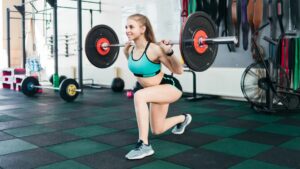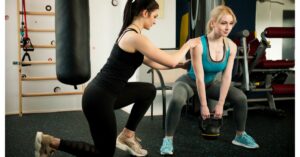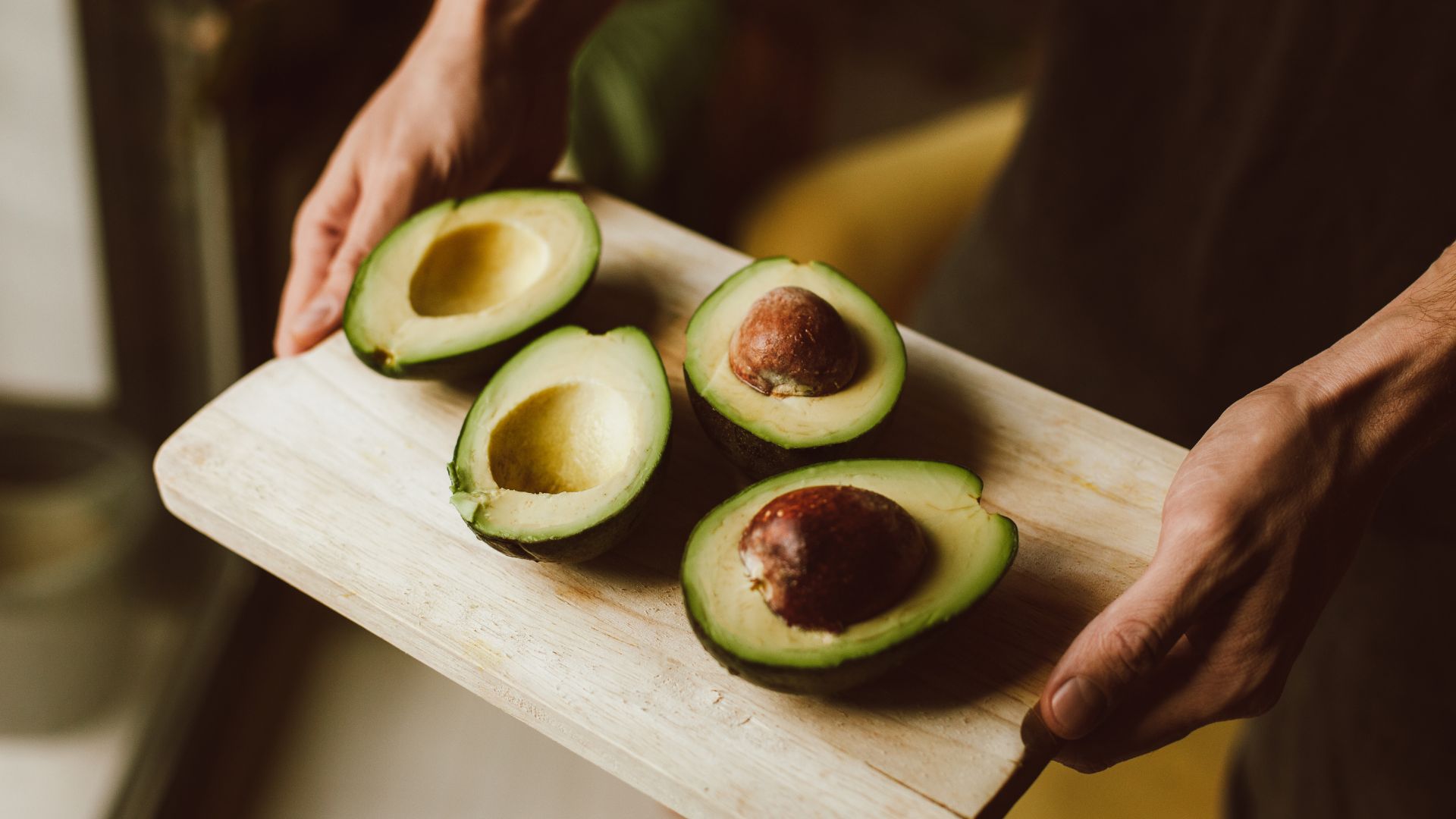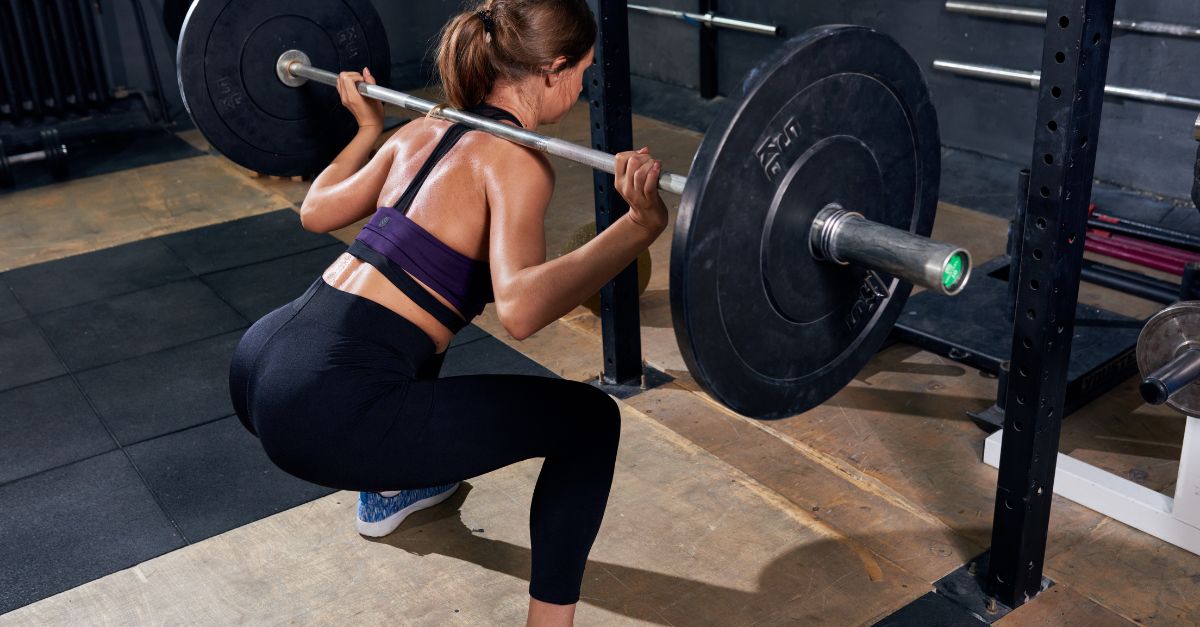Hey there, fitness enthusiasts! If you’ve ever wondered whether it’s possible to boost your squatting strength without the scale tipping in the direction of added body weight, you’re in the right place.
In this blog post, we’re diving deep into the world of strength training and exploring the strategies and secrets that can help you achieve impressive squatting gains while staying in control of your physique.
So, let’s settle the debate: Can You Get Stronger in Squatting Without Putting on Weight? Let’s find out!
Strength Gains Without the Extra Pounds: Can You Get Stronger in Squatting Without Putting on Weight?
Yes, it is possible to get stronger in squatting without necessarily putting on a significant amount of body weight.
While increased muscle mass can contribute to strength gains, there are several strategies and factors to consider,
let’s take a look at them here:
Progressive Overload: The key to getting stronger in any exercise, including squats, is to progressively increase the resistance or load over time.
You can do this by adding more weight to the barbell, using resistance bands, or adjusting other variables like sets and reps.
Optimize Technique: Improving your squatting technique can lead to strength gains without increasing body weight.
Proper form ensures that you are using the correct muscle groups efficiently and reduces the risk of injury. Consider working with a knowledgeable coach or trainer to refine your squat technique.
Periodization: Implement a structured training program that includes phases of varying intensity, volume, and specificity.
Periodization can help you break through strength plateaus without relying solely on body weight gain.
Nutrition: Although you may not want to put on extra weight, maintaining a balanced diet with adequate protein and other essential nutrients can support muscle growth and recovery, which in turn can contribute to strength improvements.
Rest and Recovery: Ensure you are allowing your muscles adequate time to recover between squatting sessions. Overtraining can hinder strength gains.
Sleep, hydration, and managing stress are also crucial for recovery.
Accessory Exercises: Incorporate accessory exercises that target muscle groups involved in squats, such as lunges, leg presses, and Romanian deadlifts.
Strengthening these muscles can translate to increased squatting strength.

Neural Adaptations: Early strength gains can be attributed to neural adaptations, such as improved motor control and coordination.
These adaptations can occur without significant muscle growth.
Consistency: Consistency is key to any strength training program. Regularly performing squats and adhering to your training plan will help you make steady progress.
It’s important to note that individual results may vary, and genetics play a role in how your body responds to training.
Some people may naturally gain more muscle mass when strength training, while others may experience more significant neural adaptations.
If your goal is to avoid significant weight gain, focus on the strategies mentioned above to increase your squatting strength while managing your body composition according to your preferences.
Further Explanations.
Let’s dive deeper and elaborate further on all the points mentioned.
Firstly, let’s delve deeper into the concepts of progressive overload and optimizing technique for squatting:
1. Progressive Overload:
Adding Weight:
One of the fundamental principles of strength training is progressive overload. To become stronger, you must continually challenge your muscles with heavier weights. This can be achieved by incrementally increasing the weight on the barbell.
For example, if you can comfortably squat a certain weight for a set number of repetitions, the next time you train, try adding a small amount of weight (e.g., 5-10 pounds or 2-5 kilograms) to the bar. This incremental increase places greater stress on your muscles, stimulating them to adapt and grow stronger.
Using Resistance Bands:
Resistance bands provide an alternative way to progressively overload your squats. You can attach resistance bands to the barbell or to your body to create additional tension throughout the squatting motion. As you become more proficient, you can use stronger bands or increase the number of bands to intensify the resistance.
Adjusting Sets and Reps:
Another way to manipulate the resistance is by altering the sets and reps in your workout routine.
For example, you can increase the number of sets or repetitions you perform with a given weight. This extended volume can stimulate muscle growth and strength gains.
2. Optimizing Technique:
Proper Form:
Squatting with correct form is crucial for both safety and effectiveness. This involves maintaining a neutral spine, engaging the core, and ensuring your knees track over your toes.
A knowledgeable coach or trainer can provide personalized guidance to help you achieve and maintain proper form.

Muscle Activation:
Proper technique ensures that you activate the target muscle groups effectively during the squat. This means engaging your quadriceps, hamstrings, glutes, and lower back muscles to lift the weight. An efficient technique distributes the load evenly among these muscles, allowing for balanced strength development.
Injury Prevention:
Correct form minimizes the risk of injury. When you squat with improper technique, you may put excessive stress on your joints or place strain on muscles that aren’t meant to handle the load. Over time, this can lead to injuries that hinder your progress.
Feedback and Correction:
Working with a coach or trainer can be invaluable for optimizing your squat technique. They can provide real-time feedback, identify areas where you need improvement, and offer corrective exercises or cues to help you perform squats safely and effectively.
In other words, progressive overload involves gradually increasing the resistance or difficulty of your squatting workouts to challenge your muscles and stimulate growth.
Optimizing technique ensures that you perform squats correctly, engage the right muscles, and reduce the risk of injury, ultimately leading to more efficient strength gains.
These two principles go hand in hand to help you improve your squatting strength without necessarily putting on additional body weight.
Let’s explore the concepts of periodization and nutrition in the context of getting stronger in squatting without significant weight gain:
3. Periodization:
Periodization is a systematic approach to organizing your training program into distinct phases or cycles, each with its own focus on intensity, volume, and specificity. Here’s how it can help you break through strength plateaus:
Phases of Training:
Periodization typically consists of several phases, including the preparation phase, hypertrophy phase, strength phase, and peaking phase. Each phase has a specific goal and training emphasis.
Intensity:
During the strength phase of periodization, you’ll work with heavier weights and lower repetitions. This phase is dedicated to building pure strength. By gradually increasing the intensity over time, your neuromuscular system adapts to handling heavier loads, leading to strength gains.
Volume:
The hypertrophy phase focuses on higher volume, which means more sets and repetitions with moderate weights. This phase can help increase muscle size and improve muscular endurance, indirectly contributing to squat strength.
Specificity:
Throughout the periodization cycle, exercises are chosen to be specific to your goals. For squats, this means including variations of the squat, such as front squats or pause squats, to address weaknesses and promote overall strength development.
Recovery:
Periodization allows for planned recovery periods, reducing the risk of overtraining and injury. Adequate rest between phases helps your body recuperate and prepare for the next phase of training.
4. Nutrition:
While your goal is to avoid significant weight gain, nutrition plays a critical role in supporting muscle growth, recovery, and strength improvements:
Protein Intake:
Protein is essential for muscle repair and growth. Ensure that your diet includes an adequate amount of high-quality protein sources like lean meats, poultry, fish, dairy, eggs, and plant-based options such as beans and tofu.

Caloric Balance:
You can maintain or slightly adjust your caloric intake to match your energy expenditure. This way, you won’t experience significant weight gain, but you’ll have enough energy to fuel your workouts and support muscle recovery.
Macronutrients:
Balance your macronutrients, including carbohydrates and fats, to provide sustained energy for workouts and recovery.
Micronutrients:
Ensure you get a variety of vitamins and minerals through a well-rounded diet or consider supplements if you’re deficient in certain nutrients.
Hydration:
Staying adequately hydrated is crucial for muscle function and recovery. Dehydration can impair your strength and performance.
Meal Timing:
Consider optimizing your nutrient intake around your workouts. Consuming a balanced meal or snack with protein and carbohydrates before and after your training session can aid in muscle recovery and growth.
In all this, periodization allows you to strategically structure your training program to break through strength plateaus without relying solely on body weight gain.
Proper nutrition, with an emphasis on protein and overall nutrient intake, supports muscle growth and recovery without necessarily leading to significant weight gain.
Combining these two approaches can help you achieve your strength goals while managing your body composition according to your preferences.
Here’s a table summarizing the key nutritional guidelines recommended for supporting muscle growth, recovery, and strength improvements while avoiding significant weight gain:
| Nutritional Component | Description |
|---|---|
| Adequate Protein | Consume enough high-quality protein sources like lean meats, poultry, fish, dairy, eggs, beans, tofu, etc. to support muscle repair and growth. Aim for around 1.2 to 2.2 grams of protein per kilogram of body weight per day, depending on your activity level and goals. |
| Balanced Diet | Maintain a balanced diet that includes a variety of food groups, including carbohydrates, proteins, fats, fruits, vegetables, and whole grains, to provide the necessary nutrients for overall health and performance. |
| Caloric Balance | Adjust your calorie intake to match your energy expenditure. Monitor your calorie intake and expenditure to maintain your current weight while supporting muscle growth and exercise performance. |
| Micronutrients | Ensure you get a wide range of vitamins and minerals through your diet or supplements if needed. These micronutrients play essential roles in muscle function and overall health. |
| Hydration | Stay well-hydrated by drinking adequate water throughout the day. Dehydration can impair muscle function and hinder recovery. |
| Pre-Workout Nutrition | Consume a balanced meal or snack with protein and carbohydrates before your workout to provide energy and support muscle performance. |
| Post-Workout Nutrition | After your workout, have a meal or snack that includes protein and carbohydrates to aid in muscle recovery and replenish glycogen stores. |
Following these nutritional guidelines can help you support muscle growth and recovery, which in turn contributes to strength improvements while managing your body weight according to your preferences.
let’s delve deeper into the importance of rest and recovery, as well as the role of accessory exercises in improving squatting strength:
5. Rest and Recovery:
Muscle Repair and Growth:
When you engage in intense squatting sessions, your muscles experience microscopic damage. Proper rest allows these muscles to repair and adapt, leading to increased strength. Without adequate rest, this repair process is disrupted, potentially hindering your progress.
Overtraining Prevention:
Overtraining occurs when you consistently push your body without giving it sufficient time to recover. This can lead to decreased performance, increased risk of injury, and a plateau in strength gains. To avoid overtraining, it’s essential to schedule rest days into your training program.
Sleep:
Quality sleep is vital for muscle recovery and overall well-being. During deep sleep, your body releases growth hormone, which is crucial for muscle repair and growth. Aim for 7-9 hours of uninterrupted sleep per night.
Hydration:
Staying well-hydrated is essential for muscle function and recovery. Dehydration can lead to muscle cramps and decreased performance. Consume an adequate amount of water throughout the day, especially before, during, and after workouts.
Stress Management:
High stress levels can increase the production of cortisol, a hormone that can hinder muscle recovery and growth. Incorporate stress management techniques such as meditation, deep breathing, or yoga into your routine to promote a more conducive environment for strength gains.
6. Accessory Exercises:
Lunges:
Lunges target the quadriceps, hamstrings, and glutes, which are also heavily involved in squats. Including lunges in your training program can strengthen these muscle groups, complementing your squatting strength.
Leg Presses:
Leg presses are an excellent exercise for developing leg strength, particularly the quadriceps. They provide a different movement pattern than squats, which can help address muscle imbalances and weaknesses.
Romanian Deadlifts:
Romanian deadlifts primarily target the hamstrings and lower back muscles. Strengthening these muscles can improve your posterior chain strength, which is essential for maintaining balance and stability during squats.
Single-Leg Exercises:
Exercises like single-leg squats or Bulgarian split squats can help identify and address strength disparities between your legs, promoting better overall squat performance.
Core Work:
A strong core is crucial for squat stability. Incorporate exercises such as planks, Russian twists, or hanging leg raises to strengthen your core muscles.
By including these accessory exercises in your training regimen, you can enhance the strength and stability of the muscle groups involved in squats.
This, in turn, can translate to improved squatting performance without necessarily requiring significant weight gain.
Additionally, by prioritizing rest, sleep, hydration, and stress management, you create an optimal environment for recovery and overall progress in your strength training journey.
let’s explore the concepts of neural adaptations and consistency in the context of improving squatting strength without significant weight gain:
7. Neural Adaptations:
Improved Motor Control:
Neural adaptations refer to changes in your nervous system’s ability to recruit and coordinate muscle fibers efficiently. When you start a strength training program, especially squats, your body becomes better at activating the right muscles in the correct sequence. This improved motor control allows you to lift weights more efficiently, leading to early strength gains.
Increased Coordination:
Squatting requires precise coordination between various muscle groups, including the quadriceps, hamstrings, glutes, and core. Neural adaptations enhance this coordination, making your movements smoother and more effective.
Skill Development:
Squatting is a skill that improves with practice. As you consistently perform squats, your body becomes more adept at executing the movement pattern correctly. This can lead to immediate strength gains without a significant increase in muscle mass.
Maximizing Existing Muscle:
Neural adaptations can enable you to fully utilize the existing muscle mass you have. In other words, even without substantial muscle growth, you can tap into your body’s potential strength by optimizing neural efficiency.
8. Consistency:
Regular Training:
Consistency is a cornerstone of any successful strength training program. Irregular or sporadic training can result in setbacks and hinder your progress. Regularly performing squats, ideally following a structured training plan, allows your body to adapt and grow stronger over time.
Here’s a table summarizing the recommended training guidelines for maintaining consistency in your squatting program:
| Training Consistency Guidelines | Description |
|---|---|
| Regularity | Schedule specific days and times for your squat workouts and stick to this schedule as consistently as possible. |
| Training Frequency | Aim to include squatting exercises in your routine at least 2-3 times per week to reinforce the movement pattern and build strength. |
| Progressive Overload | Gradually increase the resistance (weight) for your squats over time to ensure that you are continually challenging your muscles. |
| Form and Technique | Prioritize maintaining proper squat form and technique during every session. Consistency in form helps prevent injuries and ensures efficient muscle engagement. |
| Warm-Up Routine | Develop a consistent warm-up routine that includes dynamic stretches and mobility exercises specific to squatting to prepare your body for the workout. |
| Cool-Down and Stretching | Incorporate post-workout stretching and cool-down exercises to aid in muscle recovery and flexibility. |
| Tracking Progress | Keep a training log to record your squat performance, including weights lifted, sets, reps, and any notes on how you felt during the workout. |
| Variation and Periodization | While consistency is key, periodically introduce variations to your squat routine to prevent plateauing and keep workouts engaging. |
| Rest Days | Include rest days in your routine to allow your muscles to recover and prevent overtraining. Consistent rest is vital for long-term progress. |
| Listen to Your Body | Pay attention to how your body responds to training. If you feel fatigued or notice discomfort, be consistent in adjusting your training intensity or taking extra rest as needed. |
These training consistency guidelines will help you maintain a structured and effective squatting program, ensuring that you make steady progress over time.
Progress Tracking:
Consistency enables you to track your progress accurately. By consistently recording your squatting performance (e.g., weights lifted, repetitions, and sets), you can identify areas of improvement and make informed adjustments to your training plan.
Preventing Detraining:
If you take extended breaks from strength training, your body may experience detraining effects, where some of your hard-earned gains are lost. Consistency helps maintain the adaptations you’ve developed and minimizes detraining setbacks.
Building Habits:
Consistency also helps build a positive training habit. When you make squatting a regular part of your routine, it becomes easier to prioritize and stick to your strength training goals.
In summary, neural adaptations can lead to early strength gains in squats by improving motor control, coordination, and skill development, all without requiring significant muscle growth.
However, to maximize these adaptations and make sustained progress, consistency in your training program is essential.
Regularly performing squats, tracking your progress, and adhering to your training plan will allow you to make steady and significant improvements in your squatting strength over time, even if you aim to avoid significant weight gain.
A complete tabular on this topic here.
Here’s a complete table summarizing the various factors and strategies for getting stronger in squatting without necessarily putting on weight:
| Factors/Strategies | Description |
|---|---|
| Progressive Overload | Gradually increase resistance (weight) for squats over time. |
| Optimizing Technique | Ensure correct squat form to efficiently use muscle groups. |
| Periodization | Structured training phases with varying intensity and volume. |
| Nutrition | Maintain a balanced diet with adequate protein and nutrients. |
| Rest and Recovery | Allow muscles to recover, prioritize sleep, hydration, stress management. |
| Accessory Exercises | Include exercises targeting squat-related muscle groups. |
| Neural Adaptations | Improved motor control, coordination, and skill development. |
| Consistency | Regularly perform squats and adhere to your training plan. |
These factors and strategies can help you improve your squatting strength while managing your body weight according to your preferences.
Conclusion.
Yes, it is possible to get stronger in squatting without necessarily putting on weight.
By focusing on factors like progressive overload, optimizing technique, periodization, nutrition, rest, accessory exercises, neural adaptations, and consistency, individuals can enhance their squatting strength while controlling their body weight according to their goals and preferences.

Hey there, it’s Mike Rrsq, the Editor-in-Chief over at Jsquat.com, and I’m absolutely obsessed with all things squat fitness! I’ve been lucky enough to get some serious recognition for my work in this field. With a solid background in the fitness and wellness industry, I’ve been there right from the get-go, helping shape this website into what it is today.
You see, I’m not just the boss around here; I’m also a passionate contributor. I love sharing my insights through my articles, and trust me, they’re not your run-of-the-mill stuff. Each piece I write is a labor of love, filled with my expertise and real-world experience in the fitness universe. So, if you’re into fitness and looking for some inspiration, you’re in the right place!

